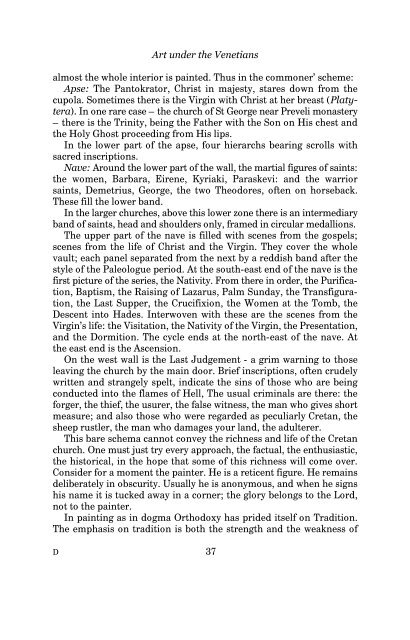free download here - Michael Llewellyn-Smith
free download here - Michael Llewellyn-Smith
free download here - Michael Llewellyn-Smith
You also want an ePaper? Increase the reach of your titles
YUMPU automatically turns print PDFs into web optimized ePapers that Google loves.
Art under the Venetians<br />
almost the whole interior is painted. Thus in the commoner’ scheme:<br />
Apse: The Pantokrator, Christ in majesty, stares down from the<br />
cupola. Sometimes t<strong>here</strong> is the Virgin with Christ at her breast (Platytera).<br />
In one rare case – the church of St George near Preveli monastery<br />
– t<strong>here</strong> is the Trinity, being the Father with the Son on His chest and<br />
the Holy Ghost proceeding from His lips.<br />
In the lower part of the apse, four hierarchs bearing scrolls with<br />
sacred inscriptions.<br />
Nave: Around the lower part of the wall, the martial figures of saints:<br />
the women, Barbara, Eirene, Kyriaki, Paraskevi: and the warrior<br />
saints, Demetrius, George, the two Theodores, often on horseback.<br />
These fill the lower band.<br />
In the larger churches, above this lower zone t<strong>here</strong> is an intermediary<br />
band of saints, head and shoulders only, framed in circular medallions.<br />
The upper part of the nave is filled with scenes from the gospels;<br />
scenes from the life of Christ and the Virgin. They cover the whole<br />
vault; each panel separated from the next by a reddish band after the<br />
style of the Paleologue period. At the south-east end of the nave is the<br />
first picture of the series, the Nativity. From t<strong>here</strong> in order, the Purification,<br />
Baptism, the Raising of Lazarus, Palm Sunday, the Transfiguration,<br />
the Last Supper, the Crucifixion, the Women at the Tomb, the<br />
Descent into Hades. Interwoven with these are the scenes from the<br />
Virgin’s life: the Visitation, the Nativity of the Virgin, the Presentation,<br />
and the Dormition. The cycle ends at the north-east of the nave. At<br />
the east end is the Ascension.<br />
On the west wall is the Last Judgement - a grim warning to those<br />
leaving the church by the main door. Brief inscriptions, often crudely<br />
written and strangely spelt, indicate the sins of those who are being<br />
conducted into the flames of Hell, The usual criminals are t<strong>here</strong>: the<br />
forger, the thief, the usurer, the false witness, the man who gives short<br />
measure; and also those who were regarded as peculiarly Cretan, the<br />
sheep rustler, the man who damages your land, the adulterer.<br />
This bare schema cannot convey the richness and life of the Cretan<br />
church. One must just try every approach, the factual, the enthusiastic,<br />
the historical, in the hope that some of this richness will come over.<br />
Consider for a moment the painter. He is a reticent figure. He remains<br />
deliberately in obscurity. Usually he is anonymous, and when he signs<br />
his name it is tucked away in a corner; the glory belongs to the Lord,<br />
not to the painter.<br />
In painting as in dogma Orthodoxy has prided itself on Tradition.<br />
The emphasis on tradition is both the strength and the weakness of<br />
D 37


